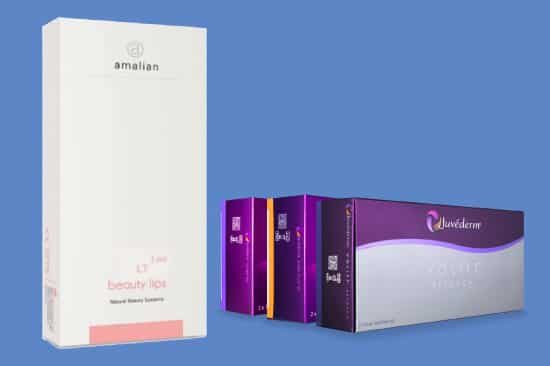Adults who are seeking to revive their youthful skin can be spoilt for choice due to the vast variety of dermal fillers available in the market. These fillers are non-invasive, biocompatible, and can remove imperfections caused by aging and lifestyle stressors. Currently, most fillers use hyaluronic acid or hyaluronan as its main ingredient, which has proven to be successful in fulfilling the aformentioned requirements.
Juvederm is a well-known dermal filler brand marketed in the US and other countries. It removes mild to deep lines found on the skin and lifts sagging jowls successfully. Amalian, on the other hand, is an aesthetic filler that has been gaining attention from the aesthetics industry for its impressive efficiency.
The similarities between Amalian and Juvederm
The products of the Amalian and Juvederm brands are hyaluronic acid-based dermal fillers. This main ingredient is a naturally-occurring substance in the body that has the potential to attract water molecules at a rate of 1,000 times its own weight. The natural and gradual depletion of its concentration in the body due to aging brings about unfavorable effects to one’s skin condition mainly in respect to the loss of elasticity, volume, and radiance.
By replacing the hyaluronic acid content in the trans-epidermal layer of the skin, the skin undergoes a restoration in dermal volume and dermal cell functions. This includes the migration of fibroblasts and the rebuilding of collagen network. Both brands source their hyaluronic acid from bacterial biofermentation, so the products of each brand are of non-animal origin.
The fillers from these two brands may be of the type that produce temporary results, though they do last for a minimum of six months to a year. Both these brands produce their fillers in gel-like solutions, to enable being injected in an intra-dermal manner, delivering immediate volume enhancement and hydration. Following the procedure, a gentle massage with proper aftercare, the initial swelling from these fillers will subside and settle into the expected result and appearance. The rewarding outcome of such a treatment is that the results can look natural and youthful yet requiring minimal downtime compared to a surgical procedure.
The differences between Amalian and Juvederm’s hyaluronan
How do these two brands differentiate in terms of their specialty when they offer the same substance? The answer lies in the way the structural composition of the hyaluronic acid, its concentration, and the way it is processed in the respective products of these brands.
Juvederm products mainly consists of homogenous hyaluronic acid that is cross-linked through the use of a reticulating agent called BDDE. This creates a variety of concentrations that are ideal for a number of specific indications, including treating moderate to deep nasolabial folds and marionette lines, treating fine lines, reversing volume loss, and lip augmentation. Vycross, a technology used in some Juvederm products, crosslinks low- and high-molecular-weight hyaluronic acid together to prolong the endurance of the finished acid for up to 18 months.
The Amalian LT range prepares monophasic, soft cross-linked hyaluronic acid to treat fine to moderate folds found on the facial skin and lips. The concentration and density of the cross-linking is adjusted according to the optimal viscoelasticity. The Expert line uses its unique Core-in-Shell (CIS) technology, a process that forms biphasic hyaluronic acid. This technology creates stable and highly cross-linked hyaluronic acid micro-particles that are protected by long chains of non-crosslinked hyaluronic acid.
Both aesthetic filler brands are designed to be highly viscoelastic. Juvederm’s hyaluronic acid maintains its cross-linking shape during the injection, but it has the ability to mold and fix itself to the surrounding contours of the face. Depending on the particular gel’s concentration, some Juvederm products’ gel can be fixed from the subdermal layer, while other Juvederm products’ gel can be fixed from the deep dermal layer. For Amalian products, the gel is originally thick and viscous. The injection pressure will liquify the gel to ensure a smooth delivery from the syringe to the target area. Once the hyaluronic acid gel is in place, the structure will return into its thicker state. Compared to Juvederm, Amalian has to be injected in smaller volumes and into deeper dermal layers.
Indications for Juvederm and Amalian
Both brands offer a diverse range to achieve a holistic youthful rejuvenation. Both ranges include products that offer light skin rejuvenation through a low concentration of hyaluronic acid to products that have highly concentrated hyaluronic acid for large volume augmentation. To achieve a successful treatment, the injector must know the concentration details of each dermal filler.
Containing high concentrations of hyaluronic acid, the Amalian Expert line and Juvederm Voluma are both designed for cheek and chin augmentation. For the former, the gel has to be injected in smaller quantities, as it can distribute itself evenly into the appropriate areas. Amalian dermal fillers can last for a year to 18 months, and the same goes for Juvederm Voluma.
To enhance the fullness and contour of the lips, patients may use Amalian LT Beauty Lips or Juvederm Ultra XC or Volbella XC. These dermal fillers are tailored to subtly increase the volume of the lips while correcting the appearance of vertical lip lines.
Juvederm Ultra and Amalian LT products, which are mid-range in terms of their hyaluronic acid concentration, can last for five to six months. Patients can prolong the outcome of either of these products by scheduling repeat treatments.
Choosing the suitable dermal filler
Ultimately, each brand elicits a different response in different individuals. Doctors, beauticians, and injectors must also be well-trained in dermal filler administration. For Juvederm, it is highly recommended by many clinics nationwide. Amalian is a fairly new line that requires extra precision in injecting, as the gel faces changes in its viscosity during the procedure itself. If the injection technique is well-mastered, both injector and patient can enjoy its excellent flow properties.
If the outcome of the treatment is not as expected, both Juvederm and Amalian products can be reversed using hyaluronidase, which helps to dissolve the gel and remove debris. Injectors can remind patients to not worry about the mild swelling, redness, and irritation that appear after treatment with either product, as these symptoms typically subside within one or two weeks with either product.
A thorough consultation between both patient and injector can help prevent severe complications from occurring with a treatment of either Juvederm or Amalian products. As the hyaluronic acid dermal fillers in both brands are biotolerable and reversible, patients can return to their daily lifestyle with a newfound confidence and radiance.



















